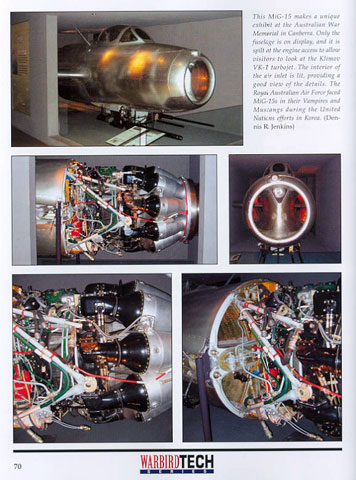S u m m a r y
|
| Title: |
Warbird Tech Series Volume 40 MiG-15
Fagot |
| ISBN: |
1580070817 |
| Media and Contents: |
Soft cover; 104 pages |
| Price: |
USD$16.95 from Specialty Press |
| Review Type: |
First Read |
| Advantages: |
Excellent
historical coverage, section dedicated to modelling the subject. |
| Disadvantages: |
|
| Recommendation: |
Recommended |
Reviewed by Ken Bowes

Warbird Tech's
MiG-15 Fagot book is available online from Squadron
Probably the first modern Soviet
fighter encountered by Western Air Forces, the MiG-15 proved to be a
worthy equal to the F-86 Sabre in the skies over North Korea, not to
mention streets ahead of the Meteors, Mustangs and Sea Fury’s flown by
Commonwealth Forces. A product of Soviet exploitation of German and
British technology, applied in a uniquely Russian way (the early
production aircraft suffered a wing-drop problem at high speed due to
inability of the factories to produce identical left and right wing
sets), the MiG-15 saw widespread service with client states around the
world when the demands of Korea eased. In Volume 40 of the Specialty
Press Warbird Tech Series Yefim Gordon, working with Peter Davison, has
produced yet another work which adds another dimension to the published
history of the MiG-15.
 Given
that this volume has been written by Gordon, who is a regular
contributor to the Red Star Series and Aerofax imprints of Midland
Counties, it comes as no surprise to find the chapters broken down in a
similar way. The first four cover design and production, including that
in Poland, Czechoslovakia and China. Then follows a chapter on
operators. This is useful for modellers as Gordon includes contemporary
photographs of the type in service and often comments on the camouflage
and markings development of the respective users. After this is an
examination of the aircraft structure and design in detail including a
colour section showing a variety of preserved and in-service types. The
Australian War Memorial’s example features here and is worthy of
inclusion for its method of display with the engine exposed and wings
removed allowing a detailed look at the internals if for nothing else. Given
that this volume has been written by Gordon, who is a regular
contributor to the Red Star Series and Aerofax imprints of Midland
Counties, it comes as no surprise to find the chapters broken down in a
similar way. The first four cover design and production, including that
in Poland, Czechoslovakia and China. Then follows a chapter on
operators. This is useful for modellers as Gordon includes contemporary
photographs of the type in service and often comments on the camouflage
and markings development of the respective users. After this is an
examination of the aircraft structure and design in detail including a
colour section showing a variety of preserved and in-service types. The
Australian War Memorial’s example features here and is worthy of
inclusion for its method of display with the engine exposed and wings
removed allowing a detailed look at the internals if for nothing else.
The final three chapters detail
the MiG-15 in service and in combat in the hands of China and Korea and
later with countries from Egypt to Afghanistan. The chapters on the
Korean War are well researched and are a real plus for this book.
Increasingly the true nature of Soviet Air Force involvement in support
of their fraternal communist partners is becoming known and Gordon has
produced an excellent summary of operations by the various VVS regiments
which made up the 64th Fighter Corps (IAK) committed to the
conflict. I found the recounting of Soviet views of No 77SQNs Meteor F
8s quite interesting. After first identifying the Meteor on gun camera
film in August 1951, the MiG pilots soon realised the superiority of
their mount. This was such that by the end of 1951 the 64th
IAK planned to take out 77SQN in its entirety in a blow aimed at
achieving a political effect by imposing an embarrassing defeated on a
key ally in the UN Forces. Whilst 77SQN fought on until the end of the
Korean War their high losses are indicative of this special attention
from the Soviet pilots.
Concluding the book are four
useful appendices. Whilst three are for dedicated facts and figures fans
(serial, production and performance stats), the fourth, “Modelling the
MiG-15”, is of direct interest to those who will use the book as a
reference for a scale replica. Richard Marmo looks at the history of
MiG-15 models from Airfix’s early 1/72 scale effort from the mid-1950’s
through to Trumpeters 1/48 and 1/32 MiG-15bis and UTI kits commenting on
accuracy and buildability.
This volume, coming across my
desk so soon after Mushroom Models Publications “Mikojan Gurievitch
MiG-15” invites comparison. The MMP book is a modeller’s reference which
includes fifty pages of detailed photographs and technical drawings. The
Warbird Tech Volume on the other hand has far more detail on the history
and employment of the type, with more overall airframe photographs and
few of close-up detail. MMP has also employed far more colour, but the
value of original photographs of in-service aircraft in the Warbird Tech
book far outweigh their inevitable black and white presentation. I would
say that the honours are about even for these two books. Both bring
different aspects to the subject into print and are to my mind
complementary volumes.
This is the first Warbird Tech volume that I have read and found it to
be of very high quality. The book will serve both history buffs and
modellers well.
Recommended.
Thanks to Karin of
Specialty Press for the review sample
Review Copyright © 2005 by
Ken Bowes
This Page Created on 21 February, 2005
Last updated 21 February, 2005
Back to HyperScale Main Page
Back to Reviews Page
|
Home | What's
New | Features
| Gallery |
Reviews | Reference
| Forum
| Search